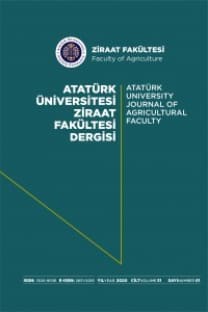Ön Islatma ve Tohum Büyüklüğünün Kurak Koşullarında Yetiştirilen Yer Fıstığında (Arachis hypogaea L. var. NSIC Pn19) Çimlenme, Kök ve Sürgün Üzerine Etkileri
Çimlenme, yer fıstığı, ön ıslatma, tohum büyüklüğü, canlılık
Effects of Hydro-priming and Seed Size on the Germination, Root, and Shoot of Peanut (Arachis hypogaea L. var. NSIC Pn18) Grown under Drought Conditions
Germination, peanut, priming, seed size, vigor,
___
- Abandani, RR, & Ramezani M. (2012). The physiological effects on some traits of osmopriming germination of maize (Zea mays L.), rice (Oryza sativa L.) and cucumber (Cucumissativus L). Int. J. Agron. 4132-148.
- Adinya, I. B., Enun, E. E. & Ijoma, J. U. (2016). Exploring profitability potentials in groundnut production through agroforestry practices: a case study in Nigeria. Journal of Animal and Plant Sciences. 20(2): 123 – 131.
- Al-Soqueer, A. A. (2004). The potential of seed soaking in sorghum (Sorghum bicolor (L) Moench) production PhD, thesis, University of Nottingham, UK
- Ashraf, M., & H. Rauf. (2001). Inducing salt tolerance in maize (Zea mays L.) through seed priming with chloride salts: Growth and ion transport at early growth stages. Acta Physiology Plant. 23407–414.
- Ashraf, M., & M. R. Foolad. (2005). Pre-sowing seed treatment a shotgun approach to improve germination, plant growth, and crop yield under saline and non-saline conditions. Adv. Agron. 88223–271.
- Ashraf, M & Iram A. (2012). Optimization and influence of seed priming with salts of potassium or calcium in two spring wheat cultivars differing in salt tolerance at the initial growth stages. Agro. Chimica. 46 47-55.
- Black, J.N. (2005). The early vegetative growth of three strains of subterranean clover (Trifolium subterraneum L.) in relation to size of seed." Australian Journal of Agricultural Research 8: 1-14.
- Chivassa, W, Harris D, Chiduza C, & P. Nayamudiza. (2000). Determination of optimum on-farm seed priming time for maize (Zea mays L.) and Sorghum (Sorghum bicolor L.) to improve stand establishment in semi-arid agriculture. Tanzanian J. Agric. Sci. 2 103-112.
- Ekpo, J. (2004). Does seed size affect the rate of germination and early seedling growth in Hairy Vetch? McCabe Thesis Collection. Paper 19.
- Harris, D. A. K. Pathan, P. Gothkar, A. Joshi, W. Chivasa & P. Nyamudeza. (2019). “On-farm seed priming: using participatory methods to revive and refine a key technology,” Agricultural Systems, vol. 69, no. 1-2, pp. 151–164, 2001.
- Khan, Ha, Ayub Cm, Pervez Ma, Bilal Rm, Shahid M. A. & K. Ziaf. (2009). Effect of seed priming with NaCl on salinity tolerance of hot pepper (Capsicum annuum L.) at seedling stage. Soil & Environ. 28 81-87
- Longer, D.E., E.J. Lorenz, and J.T. Cothren.(2006). The Influence of seed size in Soybean emergence under simulated soil crust conditions." Field Crops Research Sep (1986): 371-375.
- Matthews, S. & M. K. Hosseini. (2007). Length of the lag period of germination and metabolic repair explain vigor differences in seed lots of maize (Zea mays L). Seed. Sci. Technol. 35 200-212.
- Papong J. R. And U. A. Cagasan, (2020). Growth and Yield Performance of Upland Rice (Oryza Sativa L. var. Zambales) Intercropped with Mungbean (Vigna Radiata L.) and Peanut (Arachis Hypogaea L.) Int. J. Agric. For Life Sci. 3(1) 264-269.
- Pepper, Gary E. (2002). Will it make a difference? University of Illinois,
- Pill, W. G. & Necker AD. (2001). The effects of seed treatments on germination and establishment of Kentucky bluegrass (Poapratense L.). Seed Sci. Technol. 29: 65-72.
- Rafiq, S., Iqbal T, Hameed A. & N. Rafiqi, Z. A., Rafiq. (2006). Morpho-chemical analysis of salinity stress response of wheat. Pak. J. Bot. 38 1759-1767.
- Sanderson, M.A., Skinner, R.H. & Elwinger, G.F. (2002). Seedling development and field performance of Prairiegrass, Grazing Bromegrass, and Orchardgrass. Crop Science 42: 224-230.
- Sarcol, B. P and Cagasan, U. A. (2016). Performance of Peanut (Arachis hypogaea) as Influenced by Time of Planting Sweetpotato (Ipomea batatas L.) as Intercrop. Annals of Tropical Research 38, 122-133.
- Singn, S. P., and P.N. Bai. (2008). Effect of Seed Size upon Germination and Early Stages of Plant Growth of Cowpea (Vigna Unguiculata £.)." Acta Horticulture 12: 71-76.
- Taru, V. B., Khagya, I. Z., Mshelia, S. I. & E. F. Adebayo. (2018). Economic efficiency of resource use in groundnut production in Adamawa State of Nigeria. World Journal of Agricultural Science 56: 4896 – 900.
- Taiz, L, & E. Zeiger. (2002). Plant Physiology, 3rd edn. Sinauer Associates, Inc. Publishers, Sunderland, Massachusetts
- ISSN: 1300-9036
- Yayın Aralığı: 3
- Yayıncı: -
İvesi Koyunlarının Büyüme Eğrilerinin İzotonik Regresyon Analizi ile Tahmin Edilmesi
Tüketicilerin Kırmızı Et Tüketimi ve Hayvan Refahı Konusundaki Bilinç Düzeylerinin Araştırılması
Adile TATLIYER TUNAZ, Ali KAYGISIZ, Oğuz ARSLAN
Talip AYDIN, Abdurrahman HANAY
Mustafa TERİN, Melike CEYLAN, Kenan ÇİFTÇİ, İbrahim YILDIRIM
Trabzon’dan Ichneumonidae (Hymenoptera) Türlerine Katkılar III. Cryptinae
Fatih ÇIĞ, Murat ERMAN, Behçet İNAL, Harun BEKTAŞ, Mehmet SONKURT, Mohsen MIRZAPOUR, Mustafa CERİTOĞLU
Peyzaj Çeşitliliğindeki Zamana Bağlı Değişimin İrdelenmesi: Afşin-Elbistan Termik Santrali Örneği
Yüksel ÜNLÜKAPLAN, Elif Dilan KARAGÖZ
Ulysses CAGASAN, Van Marie Editha CAGASAN
Ülkemizde ve Dünyada Süt ve Süt Ürünlerinde Aflatoksin M1 Varlığı
